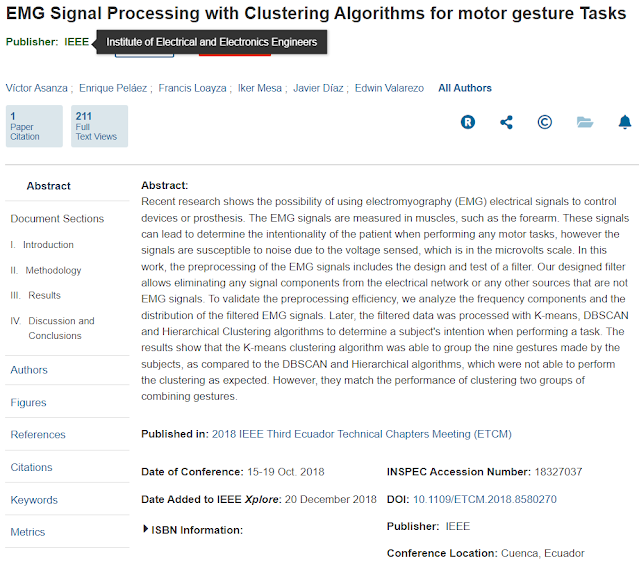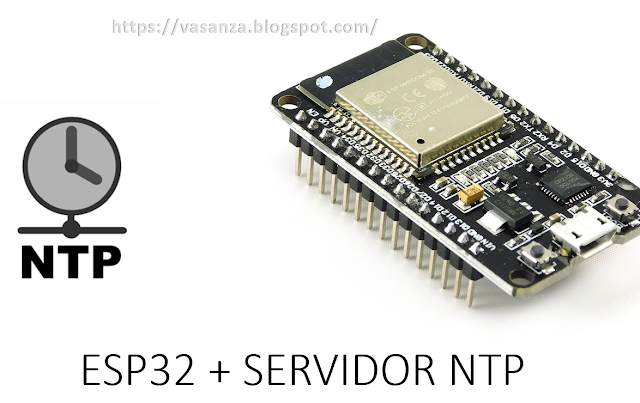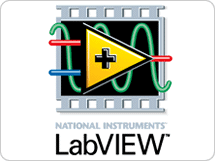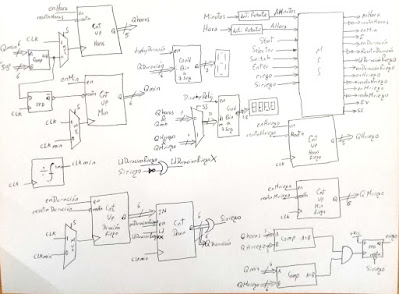▷ #EMG Signal Processing with #Clustering Algorithms for Motor Gesture Tasks
⭐⭐⭐⭐⭐ EMG Signal Processing with Clustering Algorithms for Motor Gesture Tasks from Victor Asanza Armijos
- ➡️ #EMG #Classification #HumanMachineInterface #Clustering #MachineLearning
- ➡️ ETCM2018: IEEE Ecuador Technical Chapters Meeting (ETCM)
- ⭐ Read full paper: https://ieeexplore.ieee.org/abstract/document/8580270
- When using this resource, please cite the original publication:
- ✅ Abstract:
- Recent research shows the possibility of using #Electromyography (EMG) electrical signals to control devices or prosthesis. The #EMG signals are measured in muscles, such as the forearm. These signals can lead to determine the intentionality of the patient when performing any motor tasks, however the signals are susceptible to noise due to the voltage sensed, which is in the microvolts scale. In this work, the preprocessing of the EMG signals includes the design and test of a filter. Our designed filter allows eliminating any signal components from the electrical network or any other sources that are not EMG signals. To validate the preprocessing efficiency, we analyze the frequency components and the distribution of the filtered EMG signals. Later, the filtered data was processed with K-means, #DBSCAN and Hierarchical Clustering algorithms to determine a subject's intention when performing a task. The results show that the #K_means clustering algorithm was able to group the nine gestures made by the subjects, as compared to the DBSCAN and Hierarchical algorithms, which were not able to perform the clustering as expected. However, they match the performance of clustering two groups of combining gestures.
✅ Published in: https://ieeexplore.ieee.org/abstract/document/8580270
✅ Introduction:
✅ Data Set:
✅ Methodology:
✅ Analysis and Results:
✅ Discussion and Conclusions:
✅ References:
- M. Reaz, M. Hussain and F Mohd-Yasin, "Techniques of emg signal analysis: detection processing classication and applications", Biological [1] procedures online, vol. 8, no. 1, pp. 11-35, 2006.
- W. C. Pantoja, "Neuroprotesis: Hacia un futuro de cuerpos cibernéticos", Ingeniería Industrial, vol. 26, pp. 251-266, 2008.
- A. Forero, B. Gonzalez, C. Reyes, D. Arango and E. Avila, "Diseño y construcción de un electro-miógrafo con su interfaz de visualizacion en matlab".
- I. Mesa, A. Rubio, I. Tubia, J. De No and J. Diaz, "Channel and feature selection for a surface electromyographic pattern recognition task", Expert Systems with Applications, vol. 41, no. 11, pp. 5190-5200, 2014.
- J. V. Pinzon, R. P. Mayorga and G. C. Hurtado, "Brazo robotico controlado por electromiografía", Scientia Et Technica, vol. 1, no. 52, pp. 165-173, 2012.
- K. Jerbi, J. Vidal, J. Mattout, E. Maby, F. Lecaignard, T. Ossandon, C. Hamamé, S. Dalal, R. Bouet, J.-P. Lachaux et al., "Inferring hand movement kinematics from meg eeg and intracranial eeg: From brain-machine interfaces to motor rehabilitation", IRBM, vol. 32, no. 1, pp. 8-18, 2011.
- R. Kabacoff, R in action: data analysis and graphics with R, Manning Publications Co., 2015.
- J. A. Hartigan and M. A. Wong, "Algorithm as 136: A k-means clustering algorithm", Journal of the Royal Statistical Society. Series C (Applied Statistics), vol. 28, no. 1, pp. 100-108, 1979.
- S. Bhargav and M. Pawar, "A review of clustering methods forming non-convex clusters with missing and noisy data".
- S. Mulroy, J. Gronley, W. Weiss, C. Newsam and J. Perry, "Use of cluster analysis for gait pattern classication of patients in the early and late recovery phases following stroke", Gait & posture, vol. 18, no. 1, pp. 114-125, 2003.
- J. A. Hartigan and M. A. Wong, "Algorithm as 136: A k-means clustering algorithm", Journal of the Royal Statistical Society. Series C (Applied Statistics), vol. 28, no. 1, pp. 100-108, 1979.
- Y. H. Liu, L. F. Lin, C. W. Chou, Y. Chang, Y. T. Hsiao and W. C. Hsu, "Analysis of Electroencephalography Event-Related Desynchronisation and Synchronisation Induced by Lower-Limb Stepping Motor Imagery", Journal of Medical and Biological Engineering, pp. 1-16, 2018.
- Y. Zhang, B. Liu, X. Ji and D. Huang, "Classification of EEG signals based on autoregressive model and wavelet packet decomposition", Neural Processing Letters, vol. 45, no. 2, pp. 365-378, 2017.
- V. Asanza, E. Pelaez and F. Loayza, "EEG signal clustering for motor and imaginary motor tasks on hands and feet", Ecuador Technical Chapters Meeting (ETCM) 2017 IEEE, pp. 1-5, October 2017.
- ✅ #EMG signal classification with Machine Learning using #Matlab
- ✅ #EEG signal classification with Machine Learning using #Matlab
- ✅ #EEG Signal Clustering for Motor and Imaginary Motor Tasks on Hands and Feet
- ✅ Supervised Pattern Recognition Techniques for Detecting Motor Intention of Lower Limbs in Subjects with #Cerebral_Palsy
- ✅ Clustering of #EEG Occipital Signals using #K_means




















